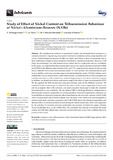Mostrar el registro sencillo del ítem
Study of effect of nickel content on tribocorrosion behaviour of nickel-aluminium-bronzes (NABs)
| dc.creator | Berlanga Labari, Carlos | es_ES |
| dc.creator | Claver Alba, Adrián | es_ES |
| dc.creator | Biezma Moraleda, María Victoria | es_ES |
| dc.creator | Palacio, José F. | es_ES |
| dc.date.accessioned | 2023-07-26T17:51:03Z | |
| dc.date.available | 2023-07-26T17:51:03Z | |
| dc.date.issued | 2023 | |
| dc.identifier.citation | Berlanga-Labari, C., Claver, A., Biezma-Moraleda, M. V., & Palacio, J. F. (2023). Study of effect of nickel content on tribocorrosion behaviour of nickel–aluminium–bronzes(Nabs). Lubricants, 11(2), 43. https://doi.org/10.3390/lubricants11020043 | en |
| dc.identifier.issn | 2075-4442 | |
| dc.identifier.uri | https://hdl.handle.net/2454/45807 | |
| dc.description.abstract | The simultaneous existence of mechanical erosion and electrochemical corrosion is a common scenario for engineering alloys used in marine environments, such as pump impellers and valves. Nickel–aluminium–bronzes (NABs) are widely used alloys in these environments due to their combination of high corrosion resistance and effective mechanical properties. However, NAB alloys are increasingly cast with reduced nickel content due to its high price and low availability. In this study, we examined the tribocorrosion behaviour of two nickel–aluminium bronzes (C95500 and C95400) with different nickel contents (4.8% and 1.0%, respectively) by means of a pin-on-disk device combined with in situ electrochemistry under 1 M NaCl solution. We conducted tests for pure wear in distilled water, pure corrosion using in situ electrochemistry under 1 M NaCl solution, and a combination of wear and corrosion, called tribocorrosion, to understand the overall synergism that exists between the two. We analysed our results using gravimetric as well as volumetric analysis; in addition, we defined the friction coefficient to compare the effect of open-circuit potential (OCP). We also applied the Tafel method and compared corrosion rates for the different scenarios. We employed confocal microscopy to delimitate the impact of the surface topography of pure wear and its synergistic effect with corrosion, and used an optical microscope to study the materials’ microstructures as cast conditions. We also utilised XRD in the Bragg–Brentano configuration to determine the chemical composition of corrosion products. From the experiments conducted, we concluded that an important synergistic effect existed between the wear and corrosion of both NABs, which was associated with corrosion-induced wear. We found NAB C95400 to be more susceptible to erosion under both conditions compared with NAB C95500 due to the chemical composition and lubricant effect of corrosion products formed during the tribocorrosion tests, which were supported by the enriched Ni corrosion products, particularly the presence of nickel-rich copper chloride, 3Cu3(CuNi)(OH)6CuCl2, in the C95500 alloy. We concluded that, because it increased the nickel content, the NAB alloy offered better wear and corrosion behaviour in sea water conditions due to its protective film nature. | en |
| dc.description.sponsorship | This research was funded by the Gobierno de Cantabria, Spain, grant number: “Estudio del comportamiento frente a cavitacion corrosion de diferentes aleaciones base cobre empleadas en el sector naval, Cavicorrnaval: SUBVTC-2021-0024” | es |
| dc.format.mimetype | application/pdf | en |
| dc.language.iso | eng | en |
| dc.publisher | MDPI | en |
| dc.relation.ispartof | Lubricants 2023, 11(2), 43 | en |
| dc.rights | © 2023 by the authors. Licensee MDPI, Basel, Switzerland. This article is an open access article distributed under the terms and conditions of the Creative Commons Attribution (CC BY) license. | en |
| dc.rights.uri | http://creativecommons.org/licenses/by/4.0/ | |
| dc.subject | Corrosion | en |
| dc.subject | Kappa phases | en |
| dc.subject | Lubricant effect | en |
| dc.subject | Marine environment | en |
| dc.subject | Nickel–aluminium–bronze (NAB) | en |
| dc.subject | Tribocorrosion | en |
| dc.subject | Wear | en |
| dc.title | Study of effect of nickel content on tribocorrosion behaviour of nickel-aluminium-bronzes (NABs) | en |
| dc.type | Artículo / Artikulua | es |
| dc.type | info:eu-repo/semantics/article | en |
| dc.date.updated | 2023-07-26T17:42:42Z | |
| dc.contributor.department | Ingeniería | es_ES |
| dc.contributor.department | Ingeniaritza | eu |
| dc.contributor.department | Institute for Advanced Materials and Mathematics - INAMAT2 | en |
| dc.rights.accessRights | Acceso abierto / Sarbide irekia | es |
| dc.rights.accessRights | info:eu-repo/semantics/openAccess | en |
| dc.identifier.doi | 10.3390/lubricants11020043 | |
| dc.relation.publisherversion | https://doi.org/10.3390/lubricants11020043 | |
| dc.type.version | Versión publicada / Argitaratu den bertsioa | es |
| dc.type.version | info:eu-repo/semantics/publishedVersion | en |



